How to cook perfect pulled pork
Is it possible to cook delicious pulled pork without the smoke and drama of a barbecue pit? Felicity Cloake says it is (just don't tell the good ol' boys ... )
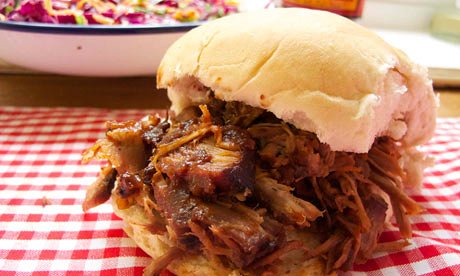
Felicity's perfect pulled pork. Photograph: Felicity Cloake
Like the Ugg boot or the skinny jean (or, indeed, the irritating sartorial singular), American food is a trend which refuses to die. And, while I get irrationally annoyed by mac and cheese, and obstinately refuse to warm to hot dogs, my love for barbecue glows as hot and bright as a burning hickory chip.
For a long time, barbecue was one of those things, like fanny packs or smiling, which was lost in translation on its way across the Atlantic. In the States, barbecue means slow, slow cooking: the hard-won fruits of smoke and devotion. In Britain, it is generally understood to be a race to burn meat before water starts falling from the sky. Pulled pork is, I think, American barbecue as its best – meat cooked so gently and tenderly that it can be gently teased apart by forks, or, more often fingers – smoky, juicy, and served with an aggressively piquant sauce, the particulars of which are the subject of fierce regional debate.
The only respectful way to cook your hog, of course, is to dig a pit, stack it with seasoned wood, and employ someone to keep it burning through the night as the meat gently smokes, but in the absence of available, and unfrozen land in the vicinity of the Guardian, and with a rusty grill currently covered in a mantle of snow, I'm going to stick with my trusty oven. Americans claim it can be done. Are they right, or just looking on the bright side, as usual?
The meat
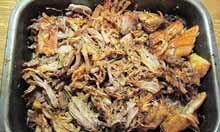
Neil Rankin recipe pulled pork. Photograph: Felicity Cloake
The traditional cut for pulled pork is the shoulder, a fatty, hard-working cheap piece of meat which demands careful, slow cooking in order to achieve the desired juicy nuggets of porcine bliss. (In eastern North Carolina, they barbecue the entire pig, but that's a different story.)
It's the top of the shoulder, known in the States as Boston butt, which is the holy grail for pulling purposes. In Britain it takes some effort to find the good stuff, but as Neil Rankin, formerly head chef at Pitt Cue Co, the South Bank's beloved-barbecue-van-made-good, instructs me, "a lot rests on the quality of the meat itself." He's helpfully specific about what to ask for: "bone in neck end ... with a good layer of fat on top." This is definitely a cut you'll need to go to a proper butchers for: none of my local supermarkets could come up with the goods.
I do try one recipe with boneless shoulder – Rachael Wass's pulled pork roll, winner of the Observer Food Monthly's reader recipe of 2012, doesn't specify bone in or bone out – but I find it the meat dries out more quickly off the bone: fatal for pulled pork
Jelly jugglers Bompas and Parr live up to their billing as "easily the most provocative players on the global food scene" by using belly in the recipe for pulled pork in their latest book Feasting – indeed, they brazenly claim that it's "the proper cut for this one". God help them if they ever try to enter the United States. Anyway, blasphemy aside, it's actually an excellent alternative to shoulder – not quite as meaty, but far quicker to cook, beautifully easy to pull and not as greasy as I'd feared. So, if belly's all you can find, you could do an awful lot worse. Just don't tell the good ol' boys.
Pre-treatment
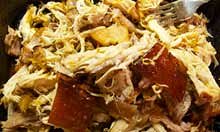
Bompas and Parr recipe pulled pork. Photograph: Felicity Cloake
Like anything to do with barbecue, pulled pork comes liberally sauced with division and contradiction – some swear by brining or rubbing the meat before cooking, for others, its integrity is sacrosanct. Rankin falls into the latter camp – the pork stands alone until it's been in the oven for six hours, and frankly, it's so beautifully juicy I'm seriously considering giving up on my quest and just cooking five more in exactly the same way and throwing a pork party, but in the interests of research, I press on.
Bompas and Parr lightly rub their pork belly joint in a cure of equal parts sugar and salt and leave it to cure in the fridge for a few hours before cooking. This draws off a quite considerable amount of moisture, which I'm not sure is entirely desirable here – pork belly has enough fat that it's in no danger of being dry, but the meat itself is slightly stringy, despite its superlative flavour.
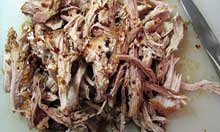
Alan Paton recipe pulled pork. Photograph: Felicity Cloake
America's Test Kitchen brines the pork butt in a mixture of salt, sugar and liquid smoke – one of those ingredients scorned by real barbecue aficionados, but which certainly does the trick at providing that elusive whiff of charred wood. My testers are all fooled, and it's undeniable that, without a barbecue to hand, this potion does indeed give the pork a gorgeous deep, smoky tang, although I'm not convinced the meat itself is any juicier after its bath.
Both Wass and Alan Paton, award-winning head chef at Essex's Stoke-by-Nayland hotel, pour a North Carolina-style "vinegar mop" or sauce over the top of the meat before cooking. I like Paton's cider vinegar, dark brown sugar, salt and chilli sauce in particular, but, after eating a decade's worth of pulled pork in a week, I feel qualified to suggest it's better to add it to taste, rather than baking the tangy flavour into the meat itself – it makes the contrast between the rich pork and the piquant dressing more satisfying.
Temperatures and times
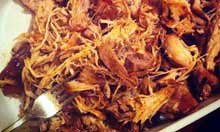
America's Test Kitchen recipe pulled pork. Photograph: Felicity Cloake
I don't have much success with cooking the pork at a straight 170C as Wass suggests: indeed, it resists all efforts to pull it apart after the specified 2 hours. In fact, even after 4½ hours at the same temperature the America's Test Kitchen piece is a bit tough. The heat needs to come down if it's going to fall off the bone, but, then, of course, the all-important browning flavours are sacrificed.
A successful compromise, then is an initial blast of heat to brown the fat, followed by long, slow cooking – Paton and Rankin have the right idea. The latter's piece gets an hour at 200C, followed by 5½ at 125C, and then a quick final crisp at 200C, after which it fairly falls off the bone: absolutely perfect. (All right, so I have to stay up until 1am waiting for the thermometer to reach the specified 89C, but the results are well worth it – and I'm not allowed to scoff it straight away in any case, so all I lose out on is sleep.)
In fact, after pulling and seasoning the pork, it has to rest for a day in the fridge, to "relax and soak up the juices and flavour" before reheating. The experiment is a success – by the time I serve it up, it's greedily absorbed all the cooking liquid, adding considerably to its deliciousness.
A good tip I get from a very helpful amateur barbecue enthusiast by the name of Jonathan Dale is to "'tent' the pork in foil at the end as it rests, as this helps steam and soften it a bit, to help ensure it pulls".
Flavourings – there's the rub
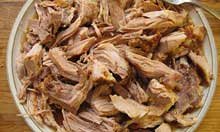
Rachael Wass recipe pulled pork. Photograph: Felicity Cloake
I'm torn here. The purists – the Bompas and Parrs and Rankins of this world – insist that, whenever you chose to do it, pulled pork should be seasoned only with sugar and salt. Things in the other camp can get bewildering: Wass rubs her pork with wholegrain mustard and chilli; America's Test Kitchen applies "yellow mustard", liquid smoke, pepper, smoked paprika and cayenne pepper; Jonathan Dale uses what he describes as a US-style barbecue rub involving smoked paprika, fennel, cumin, black pepper, cayenne, mustard powder, brown sugar, salt and garlic granules. It's smoky, aniseedy and gently spicy – absolutely delicious in fact.
In the end, however, I decide to leave the flavours to the sauce, and stick to a simple dark sugar and salt seasoning, with smoked paprika to add the desired charred flavour. The pork is rubbed before cooking, and the rest is added, Rankin-style, after pulling, so it's evenly distributed throughout the meat.
Dale also recommends basting with apple juice during cooking, but he uses a smoker – I don't find this necessary in the oven, as long as the meat itself has enough fat to keep it moist. I regret I don't manage to try out his idea of injecting it with a solution of water, apple juice and brown sugar during cooking though: along with incorporating the use of a sous-vide machine, it might be one for a second run at the process.
Perfect pulled pork
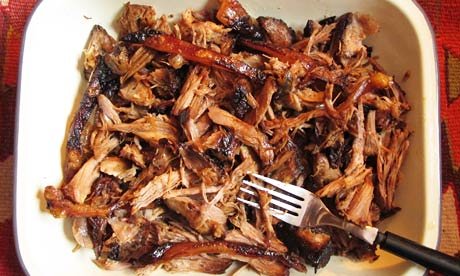
Felicity's perfect pulled pork. Photograph: Felicity Cloake
In the meantime, I truly believe this is as pretty damn close to perfect pulled pork as you can get without smoke. I leave the sauce up to you (there are some great recipes out there), but for real authenticity, it should be served stuffed into white rolls, along with enough juice to run down your chin. Bibs entirely optional.
- 1.6kg shoulder of pork from the neck end, bone in
- 2 tbsp salt
- 2 tbsp dark muscovado sugar
- 1 tbsp smoked paprika
- 2 tsp liquid smoke (optional)
1. Preheat the oven to 220C. Line a roasting tin with sheets of foil big enough to fold over the top of the pork, then pat the meat dry with a paper towel and add it to the tin. Mix together the salt, sugar and paprika and rub about half into the meat.
2. Put the pork into the hot oven for about 40 minutes until well browned, then take out and turn down the heat to 125C. Pour the liquid smoke over the pork if using, then fold the foil over the top to make a sealed parcel. Put back in the oven and cook for about 6–7 hours, until the internal temperature measures 89C and it's soft enough to spoon. Pour off the juices and reserve.
3. Turn the heat back up to 220 and cook the pork, uncovered, for 10 minutes to crisp up. Take out, cover with a tent of foil, and leave to rest for 30 minutes.
4. Use two forks, or your fingers to pull into shreds, cutting up the crackling too, and then add the rest of the seasoning, and any meat juices from the tin, and stir in. If possible, leave to soak for 24 hours before reheating in a warm oven to serve.
Is pulled pork the king of American barbecue, or do you have another favourite you'd like to see gain currency in this country? How do you eat your pulled pork – white rolls and coleslaw? And, most importantly of all, can anyone recommend a good sauce recipe?